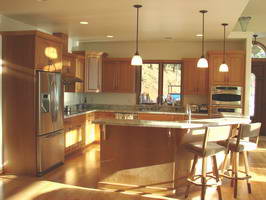How to Add a Light Fixture
 '; ';
|
Can I tie into an existing light fixture to add a new one? © By: Dave Rongey |
Adding a Light Fixture
Electrical Question: Can I tie into an existing light fixture to add a new one?
Light Fixture Wiring
- I wanted to tie into an existing ceiling light to add a fluorescent a few feet away and replace the original with a fan.
- When I opened the fixture there were two wire nuts with four black wires in one and four white in the other. Is it possible to do this, or is it already overloaded?
How to add a Light Fixture

Application: Light Fixture Wiring.
Skill Level: Beginner to Intermediate. This electrical wiring project is best performed by a Licensed Electrical Contractor.
Tools Required: Basic Hand Tools and Safe Ladder.
Estimated Time: Depends on personal experience, the type of light fixture and access to the fixture.
Precaution: Identify the light fixture circuit, turn it OFF and Tag it with a Note before working with the wiring.
Notice: Replacement parts for the light fixture should be compatible with the type of fixture that has been installed.
Dave’s Reply:
The Light Circuit Wires
Because the fixture box has 4 black and 4 white wires does not mean the circuit is overloaded and the circuit should be protected by an appropriate breaker or the fuse at the electrical panel.
The Light Circuit Load
In order to determine your circuit capacity, we have to identify the wire gauge of the circuit (not the wires of the fixture). Typically this would be a #12 which is rated for 20 amps, or #14 rated for 15 amps, #14 being smaller that the #12.
Identify the Light Circuit at the Panel
Next you need to identify this circuit at the electrical panel that supplies the power, with is either a circuit breaker or a fuse.
What Else is On the Light Circuit
Next, find out what devices (lights, plugs etc.) are on this circuit. Make a list of these devices and make note of the power that is being consumed. Simply make a list of the number of light bulbs and the watts of each bulb. If there are receptacles on this circuit, make note of the items that are typically used. Look for name plates that state watts or amps. You need to convert this total number into amps or watts.
Convert Watts to Amps for Lights
To determine watts take 120(volts) times the amps. To determine amps divide watts by 120(volts).
Then we determine 80% load factor so we do not overload the circuit:
So a #12 gauge wire can be safely loaded up to about 17 amps or 1920 watts, and a #14 gauge wire can be safely loaded up to about 12 amps or 1440 watts.
What is the Proposed Additional Light Fixture Load
Of course you need to take your proposed light fixture into consideration, and the ceiling fan, and don’t forget to deduct the original light fixture you would be removing. Also, keep in mind that we understand that the circuit will most likely never have all these devices turned on all at the same time, however we do want to identify the circuit potential load and keep the load below the maximum allowed. The circuit wiring is protected by the breaker or the fuse, and this is why we should never replace these protective devices with oversized circuit protection, but stay with the right size breaker for the wire size.
More Considerations about the Light Circuit
Ok, now that we have that out of the way, I have some things for you to consider. If you determine that your circuit will in fact allow you to add the ceiling fan, you need to make certain that the ceiling support box is in fact rated for the weight of a ceiling fan.
The Light Fixture Box
These boxes are identified with a stamp or printing stating their compliance for ceiling fans. If you are not sure, I would encourage you to replace the box with an approved box, and install wooden blocking between ceiling supports if needed. (I will be placing info about these methods on the website soon.)
Access to the Light Circuit Wiring
If you do not have access to the ceiling you may purchase an approved metal fan box kit which comes with an adjustable spanning bar, and follow the directions provided.
Light Circuit Electrical Safety
As always, positively identify your circuit and never work on an energized circuit, or perform any work where you do not feel comfortable or lack experience. It’s always best to hire a qualified licensed electrician to insure best results.
More about Electrical Wiring for a Light Fixture
Planning and Installing Home Lighting
Home lighting articles covering recessed lighting, under cabinet lighting, lighting terminology and more.
Electrical Junction Boxes for Home Wiring
Understanding electrical junction boxes and what they are used for. Home electrical wiring is the process of installing electrical wire to a location that will serve electrical devices or an appliance. One very important component is the box where the wire will be installed. The type and size of the home wiring electrical boxes will depend upon the circuit size, application and its location.
Lighting For The Home
Lighting Electrical Codes
The following may also be helpful for you:
|
|
Be Careful and Be Safe - Never Work on Energized Circuits!
Consult your Local Building Department about Permits and Inspections for all Electric Wiring Projects.
More articles about Over-Loading Circuit Questions and Home Electrical Wiring: |
|
| « Previous | Next » |
Question – Why There are Different Types of Dryer Plugs |
Question – Using CFLs Rather Than Incandescent Bulbs |















